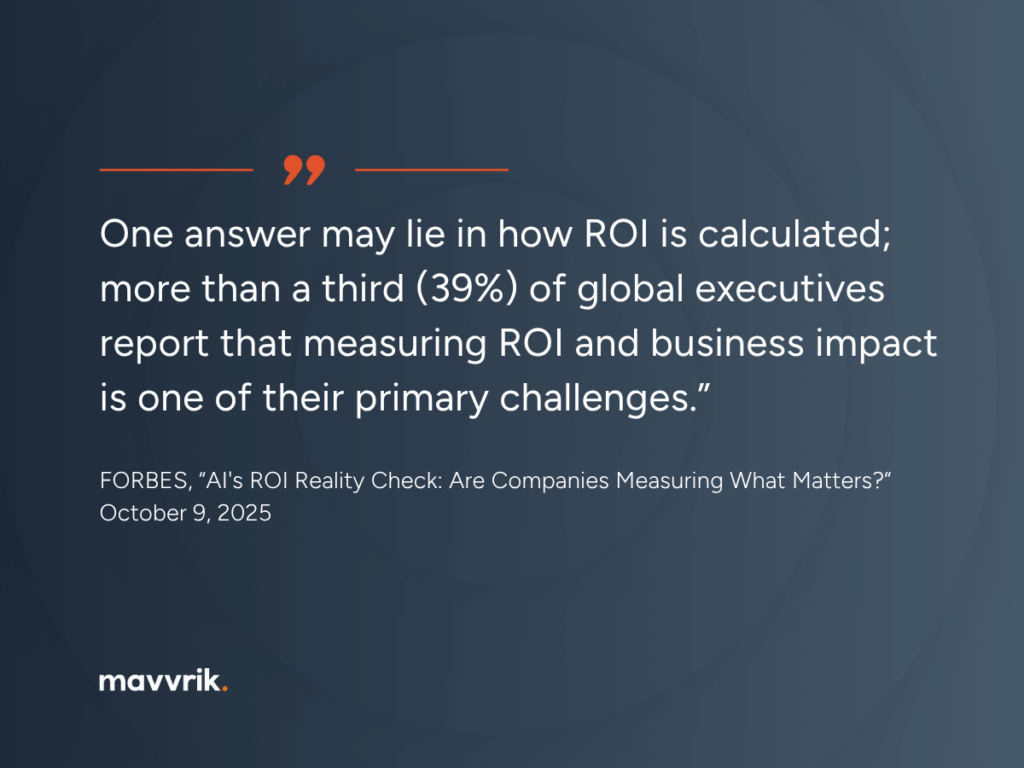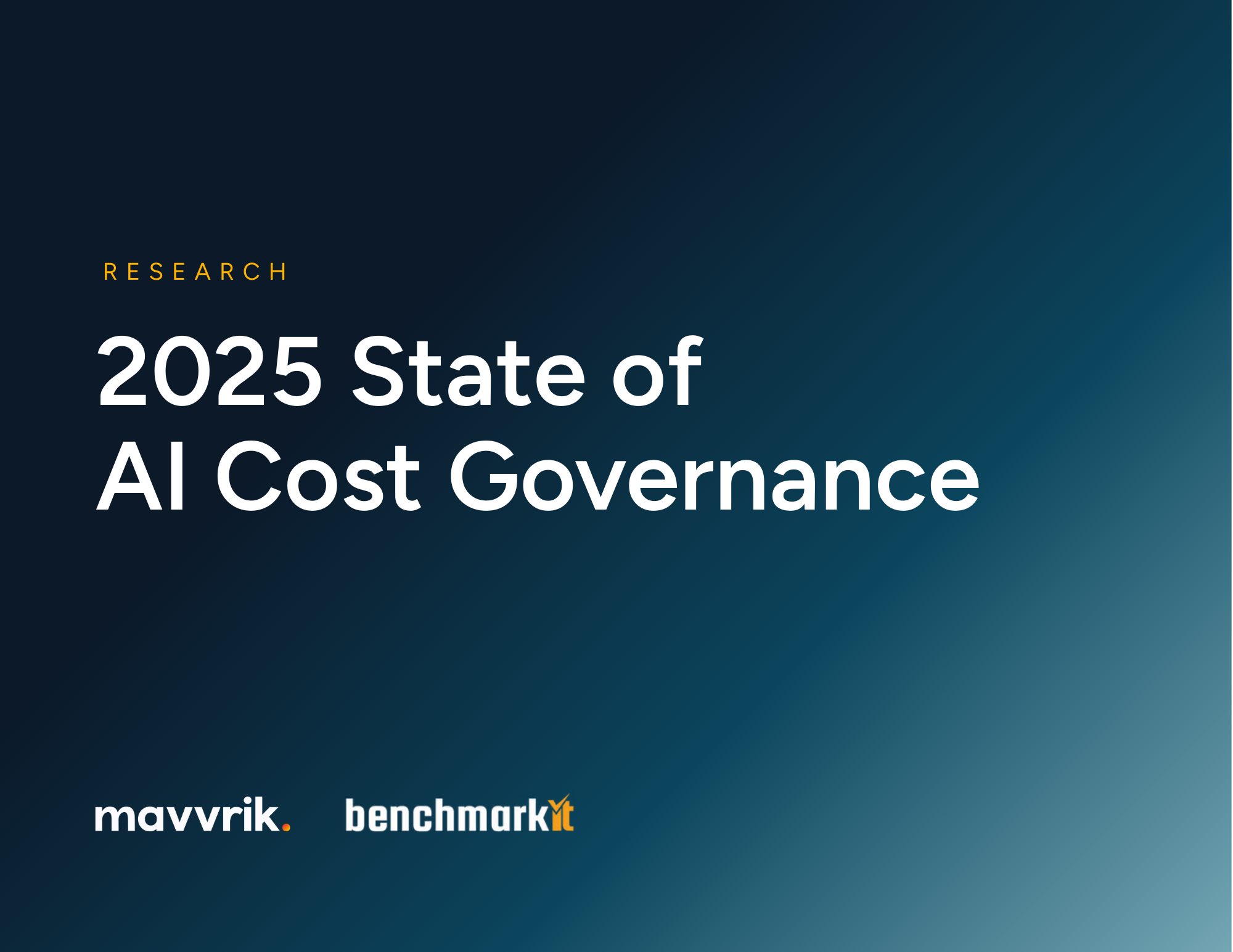AI is everywhere, but (measurable) return on investment isn’t.
The Forbes AI Study 2025 reveals a striking truth: While less than 1% of executives report achieving significant ROI from their AI investments, the more important question may be whether this metric can even be calculated accurately.
The study highlights a growing reality for enterprise leaders. AI adoption is accelerating faster than financial visibility. Organizations are scaling models, GPUs, and data pipelines without a unified view of how cost aligns to value.
It’s not just a financial challenge, it’s an operational one. Teams can measure performance outcomes, but few can connect those results to the true cost of achieving them. Until that changes, “AI ROI” will remain more aspiration than outcome.
The AI ROI Gap and What’s Behind It
The Forbes research highlights a pattern we see across many enterprises today: FOMO and eagerness to be at the forefront of AI innovation is outpacing the systems needed to govern it. Three themes stand out.
1. ROI Blind Spots Run Deep
Less than 1% of global executives surveyed say their organizations have realized a significant ROI from AI, defined as a 20% or greater profitability or cost-savings increase. Only 3% report a substantial ROI of 10–20%, while more than half (53%) say their returns remain limited to 1–5%.
At the same time, 39% of executives cite measuring ROI and business impact as one of their top challenges, and only 12% say they use AI extensively to measure the ROI of their own AI investments.
The study underscores a widespread challenge: while organizations can track AI outcomes such as improved decision-making (85%), operational efficiency (84%), and product quality (81%), most lack full visibility into the costs behind those results.
This disconnect makes it difficult for leaders to distinguish between profitable innovation and expensive experimentation.

2. AI Maturity Doesn’t Equal Financial Maturity
As AI adoption scales, executive ownership has expanded rapidly, CEO involvement has risen from 26% to 55%, COO from 2% to 41%, and CFO from 1% to 38%. But greater participation hasn’t yet translated into coordinated financial oversight.
Only 33% of respondents report regular cross-functional collaboration to align their AI initiatives, and many still manage operational and financial metrics in separate silos. Even mature programs risk overspending simply because finance and engineering lack a shared view of cost, utilization, and value.
3. Finance and Engineering Speak Different Languages
Forbes’ findings show that most enterprises measure AI success in operational terms — efficiency gains, productivity, or data quality improvements — rather than financial outcomes. While these are legitimate value indicators, they don’t connect back to cost or profitability.
Finance teams are still asking, “What did this initiative cost?” while engineering reports metrics like accuracy or latency. Both perspectives matter, but without a unified cost telemetry layer, there’s no common ROI language.
Why AI ROI will Become a Board-Level Metric
AI is no longer a side experiment. It is a cost center under increasing CFO scrutiny.
As budgets tighten and governance standards rise, executives are starting to ask harder questions:
- Which AI agents or features actually drive margin improvement?
- We built it, can we afford to scale it?
- How much does each inference or API call cost to deliver?
- What happens when GPU pricing spikes or token rates change overnight?
The conversation is shifting from “what can we build” to “what should we build, and what is it worth?”
This is where financial governance becomes foundational. The same evolution that happened in marketing, cloud, and SaaS cost management is now happening with AI.
What Enterprises Need to Close the Gap
The Forbes findings make clear that measuring AI ROI requires more than dashboards or anecdotes. It requires a unified framework that blends performance metrics with financial accountability.
From Mavvrik’s work with enterprise FinOps teams, three building blocks consistently emerge.
1. Unified Visibility Across Environments
AI workloads rarely live in one place. They span cloud, hybrid, and on-prem environments, crossing GPU clusters, model APIs, and SaaS platforms. Many of the costs are below the surface, invisible until the bill.
To measure ROI accurately, organizations need a single pane of glass that links every workload, tenant, and token back to its owner or business outcome.
2. Granular Cost Attribution
Knowing that “AI spend is up 40%” is not enough. Most companies aren’t just running one AI project, they have dozens. And they want to understand that Agent A is using 62% of budget vs Agent B which is using 2%.
Knowing which model, team, or customer drove that increase, and why, is how organizations improve ROI.
Cost-to-serve metrics, per-model chargeback, and operation-level tracking help teams pinpoint where value is being created and where waste is hiding.
3. Guardrails and Governance
Budgets drift when innovation moves faster than oversight. Predictive alerts, spend limits, and automated chargebacks create guardrails that protect experimentation while maintaining financial discipline.
How Mavvrik Helps Enterprises Achieve Real AI ROI
The trends identified in the Forbes study align closely with what Mavvrik was built to solve. Many organizations want to innovate quickly but lack the visibility to understand what their AI investments are truly delivering.
Mavvrik provides complete financial control across cloud, on-prem, AI and SaaS, helping teams turn unpredictable technology spend into managed investments.
Mavvrik Helps Enterprises and Services Providers:
- Track cost per model and operation to see the full financial footprint of every workload.
- Chargeback GPU capacity both internally or externally to maximize investments.
- Automate cost reporting to give finance and engineering a shared source of truth.
- Enforce budget guardrails that prevent cost overruns before they happen.
- Tie every dollar of AI spend to measurable business outcomes.
The outcome: AI that actually delivers measurable value.
The Bottom Line
The Forbes AI Study 2025 confirms what many leaders already know: achieving AI ROI is not just a data problem—it’s a visibility problem.
The only way to close the gap is to measure both sides of the equation: value and cost.
Most enterprises have invested heavily in tracking value creation. Mavvrik helps them master the other half by bringing precision, control, and accountability to every dollar spent on AI.
Real ROI starts when you can see where every model, token, and GPU hour goes, and what it’s worth.
FAQ: Measuring the ROI of AI
Q: What’s the biggest barrier to AI ROI?
A: Most enterprises evaluate AI success using operational metrics, efficiency gains, accuracy, or productivity, not financial ones. The challenge is that these outcomes don’t tie directly to cost or profitability. As the Forbes AI Study 2025 shows, 39% of executives cite measuring ROI and business impact as a top challenge. Without visibility into model-level costs, teams can’t determine whether those performance gains actually drive financial return.
Q: What should leadership teams focus on first when it comes to AI ROI?
Start with financial visibility. Before optimizing spend or forecasting budgets, organizations need to understand where costs originate — which models, workloads, or customers drive them — and how they align with outcomes.
This clarity enables CFOs, FinOps, and engineering leaders to set meaningful benchmarks and enforce governance that keeps innovation aligned with financial performance.
Q: How is measuring AI ROI different from traditional cloud or FinOps practices?
AI introduces an entirely new cost structure. Unlike traditional cloud workloads, AI costs fluctuate with model behavior, GPU consumption, and token-based usage, often changing minute to minute. Traditional FinOps focuses on optimizing infrastructure spend, but AI FinOps must also connect cost to outcomes.
That means tracking cost per inference, per model, or per feature and tying it back to revenue impact, accuracy gains, or customer experience. Without this deeper attribution, “optimization” becomes guesswork.
Mavvrik helps enterprises move beyond cloud-era FinOps by embedding cost visibility directly into AI infrastructure, enabling finance and engineering teams to measure performance and profitability together.
Q: How does Mavvrik improve AI ROI?
A:Mavvrik provides the financial control layer that AI environments lack. By unifying visibility across cloud, on-prem, and GPU infrastructure, the platform helps enterprises connect technical usage data to financial impact. From automated chargebacks and budget guardrails to real-time GPU efficiency tracking, Mavvrik turns AI cost management into measurable business intelligence, helping enterprises transform unpredictable spend into accountable investment.


